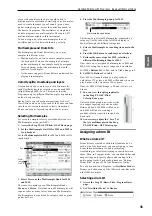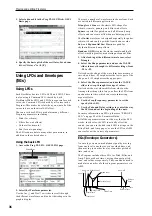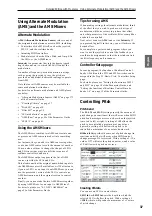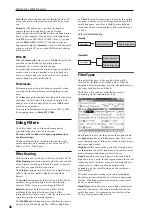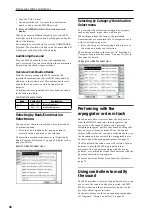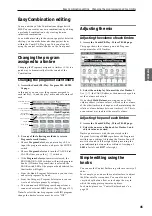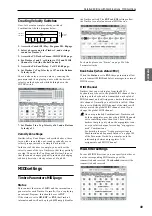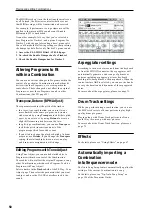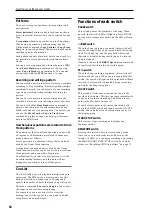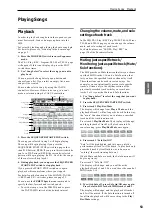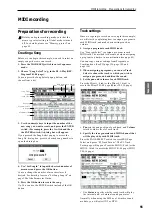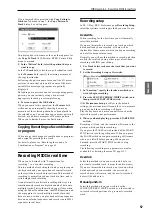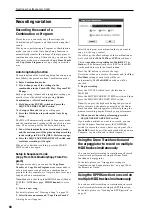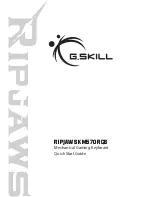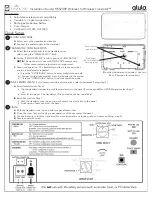
Detailed Editing with Combinations A suggested approach for editing
47
Program
Combination
Sequencer
Effect
Arpeggio
Drum Track
Global
Media
Detailed Editing with Combinations
You can edit the preloaded combinations (Banks A–C)
with which the M50 is shipped, or start with an
initialized Combination to create your own original
sounds.
You can use the factory Programs to create new
Combinations, or use your own custom Programs.
Note:
If you’re in the process of editing a Program in
Program mode, and you use that Program in a
Combination, you’ll hear the edited version in
Combination mode as well.
About the edit pages
In the Combi P0: Play page you can select and play
combinations. Here you can also use the control
surface’s knobs and the tone-adjust function for quick
editing, or to edit the settings of the arpeggiator or
drum track. In the other pages you can edit the sound
in greater detail.
For details on each mode and how to access each page,
please see “Basic operations” on page 16.
A suggested approach for
editing
First, select a Program for each Timbre, on the P0:
Play– Program T01–08 or T09–16 page. (Note that you
don’t have to use all 16 Timbres!)
Next, create any desired keyboard or velocity splits,
layers, or crossfades between the different Timbres.
You can do this on the P4: Zone/Delay– Keyboard
Zones page.
After this, adjust the volumes of the Timbres (back on
the Program Select/Mixer tab), and set up any other
Timbre parameters as desired.
To add finishing touches to the sound, set up the Insert,
Master, and Total Effect as desired (on the P8: IFX and
P9: MFX/TFX pages, respectively.) These effects can be
different from those associated with the individual
Programs in Program mode, if desired.
In addition, you can make arpeggiator and drum track
settings (on the P7: ART/DT page) and controller
settings (on the P1: Controllers page) to create the
finished Combination.
Soloing timbres
You can use the Control Surface’s Solo function to hear
the sound of each timbre by itself.
For details, please see “Solo On/Off” on page 82 of the
Parameter Guide.
Restoring edited settings
Using COMPARE
When you’re in the process of editing a sound,
pressing the COMPARE switch will recall the saved
version of the sound, as it was before you started
editing.
For details, please see “Compare function” on page 18.
Resetting individual controls
You can use the RESET CONTROLS switch to restore
the settings or default values that are saved in the
knobs.
For details, please see “Resetting the controller
settings” on page 21.
Parameters
Parameters
Parameters
Parameters
Timbre2
Timbre3
Timbre16
Timbre4
Timbre1
Parameters
Program
Program
Program
Program
Program
AUDIO OUTPUT
L/MONO, R
Master
Effects
1, 2: P9
Total
Effects:
P9
Insert
Effects
1…5: P8
Chord Trigger Switches: P1–2
Arpeggio: P7–1, 2, 3, 4, 5
Timbre
Insert Effects
Master Effects
FX Control Bus
Routing: P8-1, 2
DrumTrack: P7–7
Tone Adjust: P0–7
3Band EQ
3Band EQ
3Band EQ
3Band EQ
3Band EQ
Controllers: P1–1
Combination structure and corresponding pages
P1–1, P2–2, etc. indicate the on-screen pages and tabs used when editing on the M50.
Summary of Contents for EASYSTART M50
Page 1: ...3 E Owner s Manual ...
Page 84: ...Arpeggiator function 78 ...
Page 88: ...Drum Track function 82 ...



